All my life, I thought salamanders were horizontal creatures. Would you imagine my surprise when I was looking at one of those animal shows and I saw a salamander trying to climb vertically? I got spooked! For a few minutes, I couldn’t believe it was real!
Then I found out that some salamanders can climb walls, while others cannot. This ability depends on the species of salamander and the specific adaptations it has developed for climbing.
Here, I will cover everything regarding salamanders ability to climb walls. So, let’s begin without wasting any time.
Do Salamanders Have Webbed Feet?
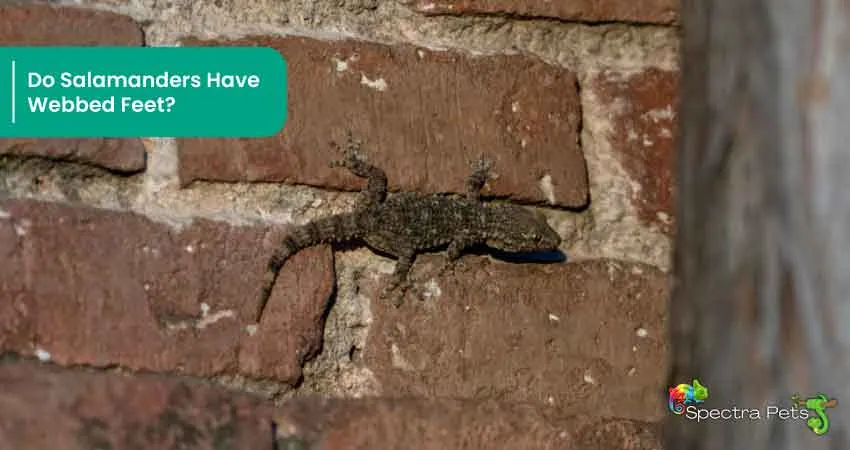
The answer is that it depends on the species of salamander. Some species of salamanders have webbed feet, while others do not. Having webbed feet allows them to climb things easier (like trees, damp walls, etc.). They get better grip due to the webbing.
Salamanders that live in aquatic environments, such as streams and ponds, are more likely to have webbed feet. This is because webbed feet can help them swim more efficiently through the water. For example, the North American tiger salamander (Ambystoma tigrinum) and the axolotl (Ambystoma mexicanum) both have webbed feet.
On the other hand, salamanders that live on land or in moist environments are less likely to have webbed feet. These salamanders rely more on their legs for movement and do not need the extra surface area provided by webbed feet to swim through water.
It’s important to note that not all aquatic salamanders have webbed feet, and not all terrestrial salamanders lack webbed feet. There is a lot of variation among salamander species, and each one has evolved to suit its specific habitat and lifestyle.
Can Salamanders Climb?
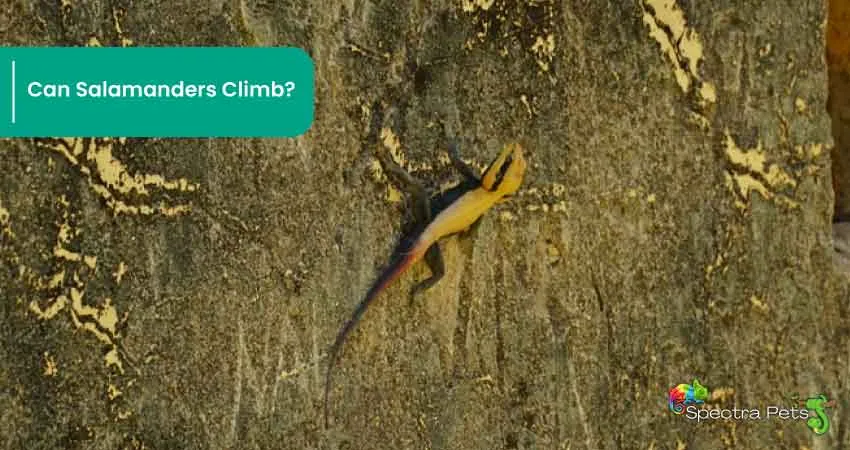
Again, some salamanders can climb, while others cannot. This ability depends on the species of salamander and the specific adaptations it has developed for climbing.
One group of salamanders that is known for its climbing ability is the Plethodontidae family, also known as lungless salamanders. These salamanders have long toes and fingers, which they use to grasp onto rough surfaces like tree trunks and rocks. They also have sticky secretions on their toes and fingers that help them cling to surfaces. These adaptations allow them to climb trees, cliffs, and even walls with ease.
Other salamanders, such as the giant salamander and the axolotl, are not known for their climbing ability. These salamanders are typically found in aquatic environments and do not have the same adaptations for climbing as the lungless salamanders.
It’s worth noting that salamanders are generally not strong climbers compared to other animals. They do not have the same strength or agility as lizards or geckos, which are known for their climbing ability. However, some salamanders are able to climb walls and other vertical surfaces with the help of their sticky toes and fingers.
How Do Salamanders Climb?
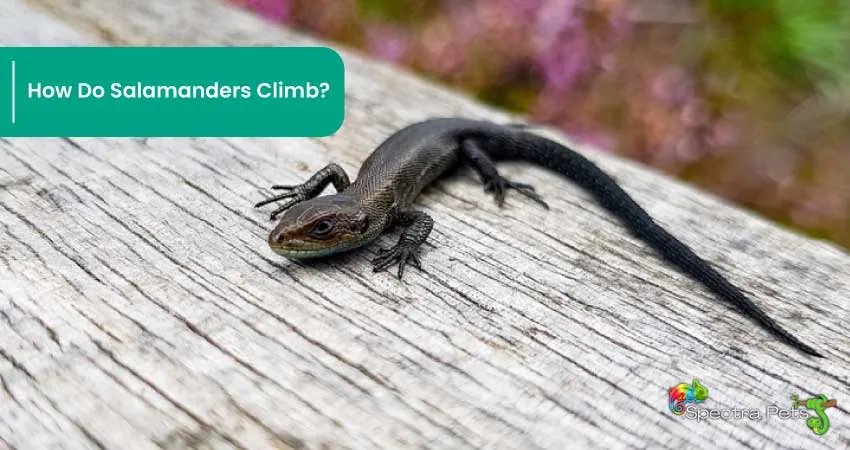
Salamanders have moist, slimy skin that helps them move easily over a variety of surfaces, including trees, rocks, and other vertical surfaces. This slimy skin, along with their sticky toes, helps them to grip surfaces as they climb. In addition, salamanders have a prehensile tail, which they can use to grasp onto branches or other objects to help them climb.
Salamanders are also able to use their body muscles to push and pull themselves up as they climb. They have powerful hind legs and a flexible spine that allow them to move easily through their environment. In addition, many species of salamanders have a flattened body shape that helps them move through tight spaces and allows them to easily navigate through the branches of trees and other vertical surfaces.
Comparison with other wall-climbing animals
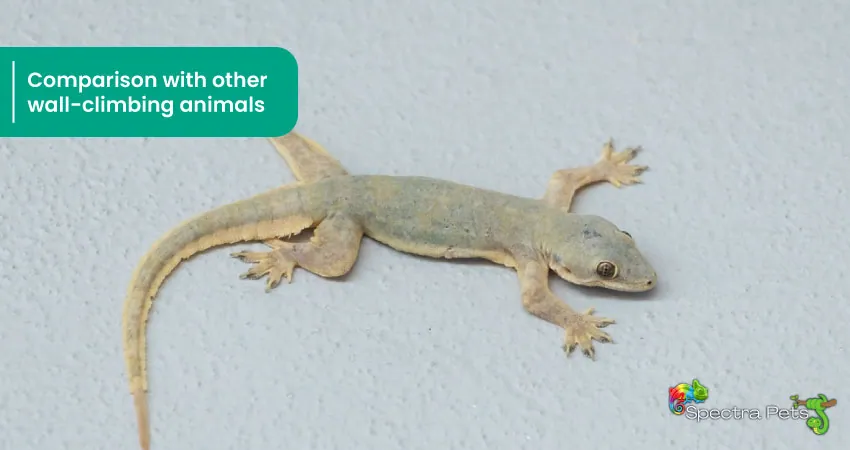
Salamanders are not the only animals that can climb walls. In fact, many other animals have adapted to climbing in order to escape predators, find food, or navigate their environment. Some other examples of animals that can climb walls include geckos, spiders, and squirrels. Each of these animals has unique adaptations that allow them to scale vertical surfaces.
One of the most well-known wall-climbing animals is the gecko. Geckos have evolved unique structures on their feet called setae, which are tiny hair-like structures that allow them to stick to surfaces. These setae work by creating intermolecular forces that keep the gecko attached to the surface they are climbing. This is known as van der Waals force.
Squirrels, on the other hand, are able to climb trees and walls due to their sharp claws and strong leg muscles. Spiders use their ability to produce silk to create webs that allow them to climb and catch prey.
While each of these animals has different adaptations that allow them to climb walls, the mechanisms behind wall-climbing are still being studied by scientists.
The science of Salamander wall-climbing
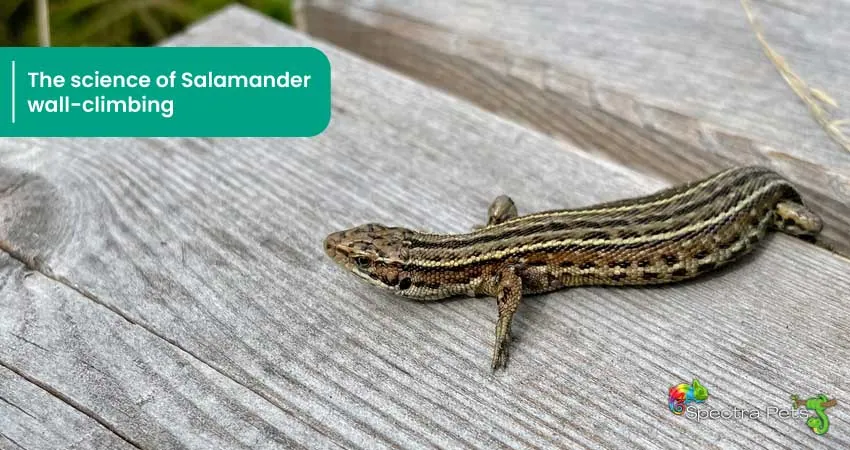
Scientific research on salamander wall-climbing has been ongoing for many years. In recent years, scientists have been able to use modern technology such as high-speed cameras and micro-CT scans to study the mechanics behind salamander wall-climbing. Researchers have discovered that salamanders use a combination of muscle power and adhesive forces to climb walls. Specifically, salamanders use a suction-like mechanism that allows them to create a vacuum with their toes, enabling them to grip onto the wall. This mechanism has been dubbed the “salamander’s kiss” by some researchers.
Mechanics of salamander wall-climbing
One study published in the Journal of Experimental Biology found that when climbing a vertical surface, the salamander’s body weight is supported entirely by their feet. This study also found that the adhesive forces produced by the salamander’s toes are greater than the animal’s body weight. Another study published in the Journal of Morphology used micro-CT scans to study the anatomy of salamander toes. This study found that the toe pads have a unique structure that allows them to conform to uneven surfaces.
Importance of Salamander wall-climbing
Salamanders play an important role in their ecosystems. As predators, they help to control populations of insects and other invertebrates. As prey, they provide a food source for many larger animals.
The ability to climb walls allows salamanders to move through their environment in unique ways, which can give them an advantage over predators or help them access new sources of food. In some cases, salamanders may even be able to move through areas that other animals cannot, which can help to disperse their populations and prevent inbreeding.
Biomimicry and technological innovations
The study of salamander wall-climbing has inspired scientists to develop new technologies and materials. For example, researchers have developed a material called Geckskin, which mimics the adhesive properties of gecko feet. This material can be used to create adhesives that can attach to a variety of surfaces.
Similarly, the study of salamander wall-climbing has led to the development of climbing robots that can move through environments that are difficult or impossible for traditional wheeled or legged robots. These robots use suction, adhesive, or other methods to climb walls or other surfaces, much like salamanders do.
In addition, the study of salamander wall-climbing has provided valuable insights into the mechanics of adhesion and friction, which could have applications in fields such as materials science and engineering.
Overall, the study of salamander wall-climbing has shown us that nature is an endless source of inspiration for new technologies and innovations. By studying the mechanisms behind animal behaviors, we can develop new materials and techniques that can improve our lives in a variety of ways.
Can Salamanders Climb Walls?
So, let’s address the main question.
Yes, some species of salamanders are able to climb walls and other vertical surfaces. Salamanders are agile and have sticky toes that help them cling to rough surfaces. However, not all species of salamanders are equally adept at climbing.
Some species, such as the axolotl, are aquatic and do not climb at all. Other species, such as the newt, are more adapted to living on land and may be more skilled at climbing. In general, salamanders that live in trees or other elevated habitats may be more likely to be good climbers than those that live on the ground.
Wrapping Up
So, Salamanders can indeed climb walls. I was as surprised as you are, trust me. Never ever I thought they’d be capable of vertical movement. But here we are! The world works in miraculous ways. Who knows what the next surprise is going to be!
References:
- Autumn, K. (2006). How gecko toes stick. American Scientist, 94(2), 130-137. doi:10.1511/2006.58.964
- Martini, F. H. W., Higham, T. E., & Kleinteich, T. (2019). Toe pad morphology and mechanisms of sticking in climbing salamanders. Journal of Morphology, 280(7), 1035-1046. doi:10.1002/jmor.20995
- Hsieh, S. T., & Gidmark, N. J. (2005). Body orientation and the adhesive forces between a climbing salamander and a vertical surface. Journal of Experimental Biology, 208(5), 829-837. doi:10.1242/jeb.01421
